tow TOYOTA PRIUS C 2017 NHP10 / 1.G Owners Manual
[x] Cancel search | Manufacturer: TOYOTA, Model Year: 2017, Model line: PRIUS C, Model: TOYOTA PRIUS C 2017 NHP10 / 1.GPages: 596, PDF Size: 10.05 MB
Page 3 of 596
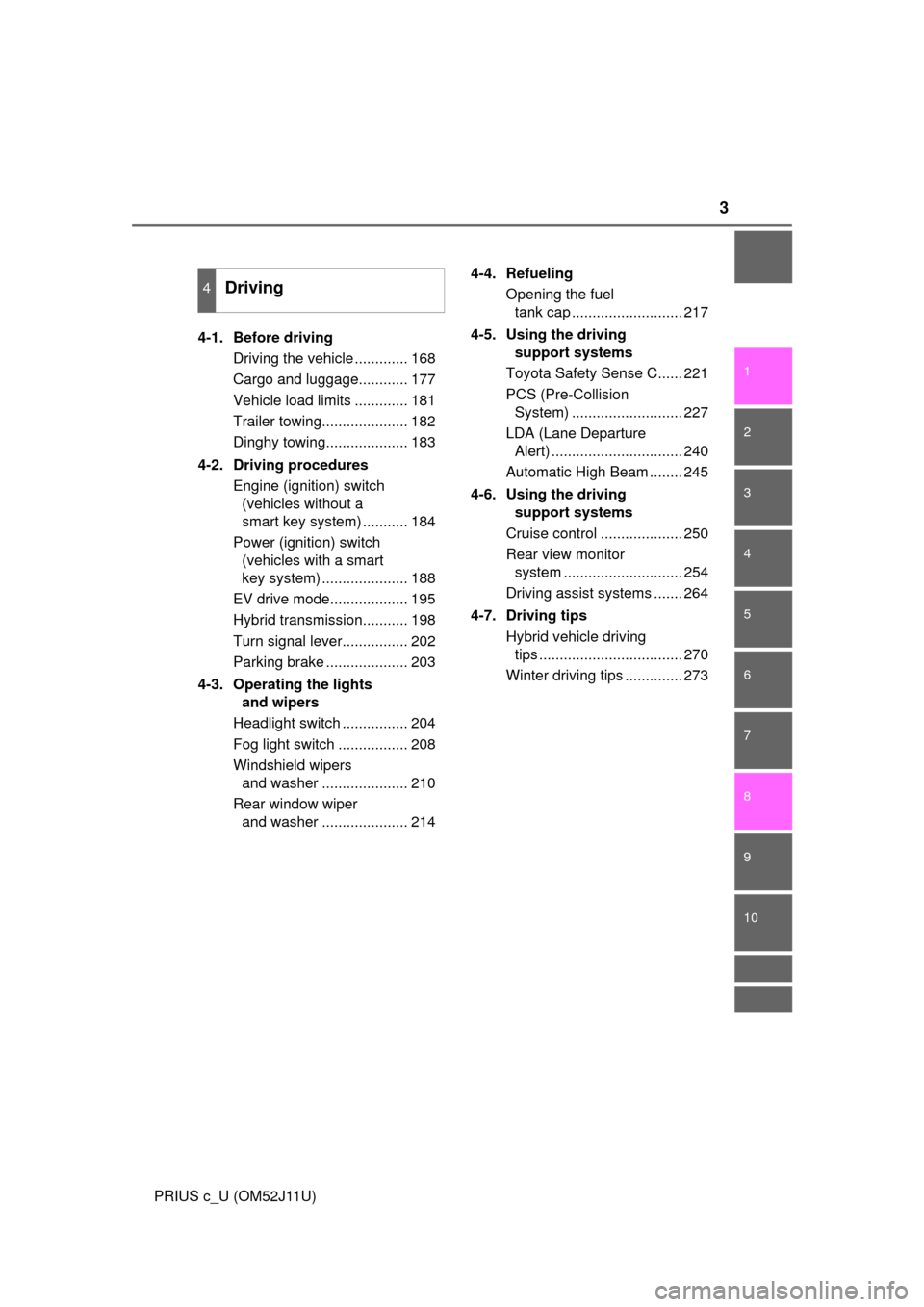
3
1
9 8 6 5
4
3
2
PRIUS c_U (OM52J11U)
10
7
4-1. Before drivingDriving the vehicle ............. 168
Cargo and luggage............ 177
Vehicle load limits ............. 181
Trailer towing..................... 182
Dinghy towing.................... 183
4-2. Driving procedures Engine (ignition) switch (vehicles without a
smart key system) ........... 184
Power (ignition) switch (vehicles with a smart
key system) ..................... 188
EV drive mode................... 195
Hybrid transmission........... 198
Turn signal lever................ 202
Parking brake .................... 203
4-3. Operating the lights and wipers
Headlight switch ................ 204
Fog light switch ................. 208
Windshield wipers and washer ..................... 210
Rear window wiper and washer ..................... 214 4-4. Refueling
Opening the fuel tank cap ........................... 217
4-5. Using the driving support systems
Toyota Safety Sense C...... 221
PCS (Pre-Collision System) ........................... 227
LDA (Lane Departure Alert) ................................ 240
Automatic High Beam ........ 245
4-6. Using the driving support systems
Cruise control .................... 250
Rear view monitor system ............................. 254
Driving assist systems ....... 264
4-7. Driving tips Hybrid vehicle driving tips ................................... 270
Winter driving tips .............. 273
4Driving
Page 6 of 596

TABLE OF CONTENTS6
PRIUS c_U (OM52J11U)7-1. Maintenance and care
Cleaning and protecting the vehicle exterior .......... 400
Cleaning and protecting the vehicle interior ........... 403
7-2. Maintenance Maintenance requirements ................... 406
General maintenance ........ 409
Emission inspection and maintenance
(I/M) programs ................ 412
7-3. Do-it-yourself maintenance
Do-it-yourself service precautions ..................... 413
Hood.................................. 416
Positioning a floor jack ...... 418
Engine compartment ......... 419
12-volt battery ................... 428
Tires .................................. 432
Tire inflation pressure........ 441
Wheels .............................. 444
Air conditioning filter .......... 446
Wireless remote control/ electronic key battery ...... 448
Checking and replacing fuses ............................... 451
Light bulbs ......................... 455 8-1. Essential information
Emergency flashers ........... 466
If your vehicle has to be stopped in an
emergency....................... 467
8-2. Steps to take in an emergency
If your vehicle needs to be towed ...................... 469
If you think something is wrong ........................... 476
If a warning light turns on or a warning buzzer
sounds ............................. 477
If a warning message is displayed...................... 486
If you have a flat tire .......... 501
If the hybrid system will not start ..................... 514
If the electronic key does not operate
properly ........................... 516
If the vehicle 12-volt battery is discharged ....... 518
If your vehicle overheats......................... 524
If the vehicle becomes stuck ................................ 528
7Maintenance and care8When trouble arises
Page 18 of 596
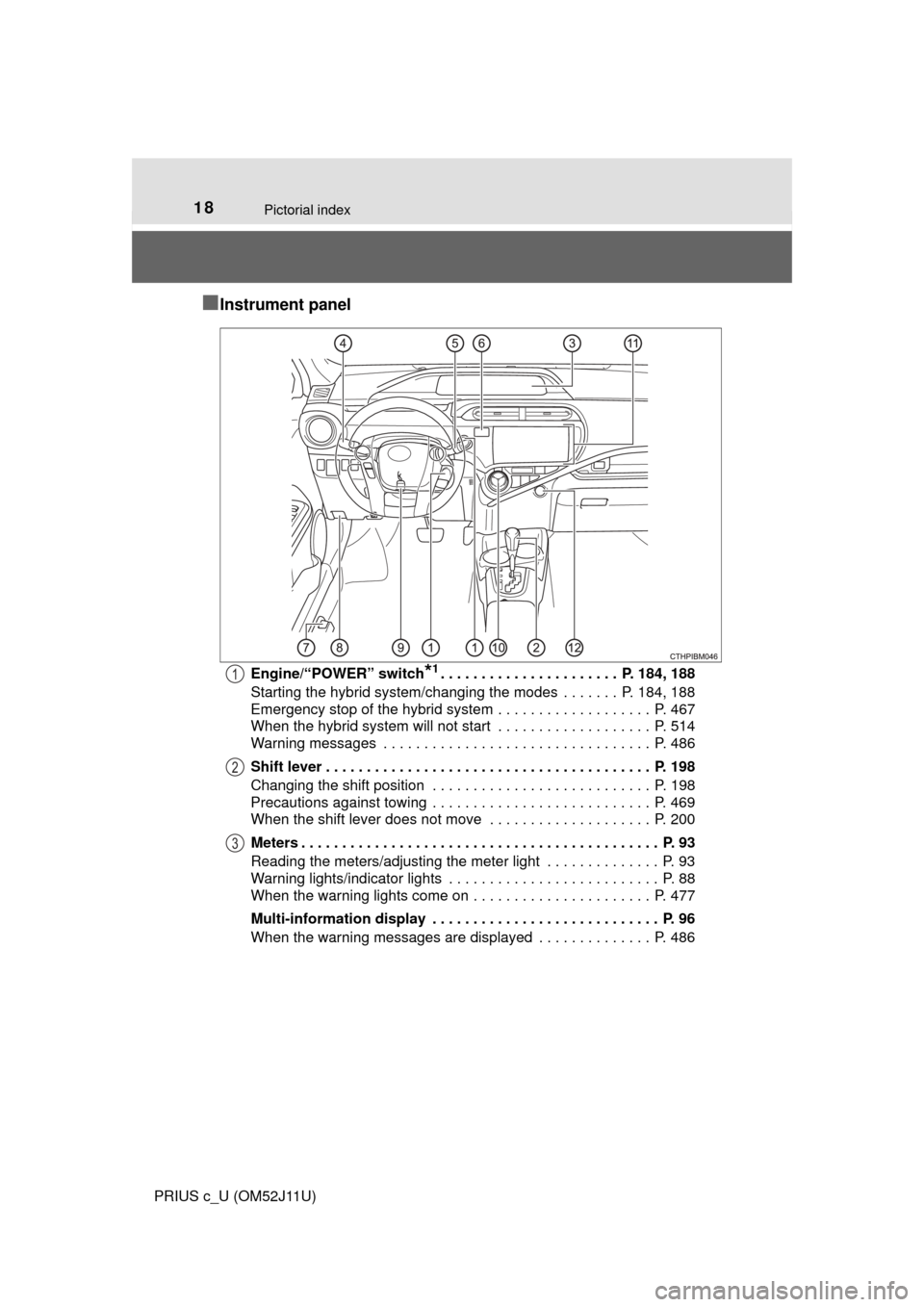
18Pictorial index
PRIUS c_U (OM52J11U)
■Instrument panel
Engine/“POWER” switch*1. . . . . . . . . . . . . . . . . . . . . . P. 184, 188
Starting the hybrid system/changing the modes . . . . . . . P. 184, 188
Emergency stop of the hybrid system . . . . . . . . . . . . . . . . . . . P. 467
When the hybrid system will not start . . . . . . . . . . . . . . . . . . . P. 514
Warning messages . . . . . . . . . . . . . . . . . . . . . . . . . . . . . . . . . P. 486
Shift lever . . . . . . . . . . . . . . . . . . . . . . . . . . . . . . . . . . . . . . . . P. 198
Changing the shift position . . . . . . . . . . . . . . . . . . . . . . . . . . . P. 198
Precautions against towing . . . . . . . . . . . . . . . . . . . . . . . . . . . P. 469
When the shift lever does not move . . . . . . . . . . . . . . . . . . . . P. 200
Meters . . . . . . . . . . . . . . . . . . . . . . . . . . . . . . . . . . . . . . . . . . . . P. 93
Reading the meters/adjusting the meter light . . . . . . . . . . . . . . P. 93
Warning lights/indicator lights . . . . . . . . . . . . . . . . . . . . . . . . . . P. 88
When the warning lights come on . . . . . . . . . . . . . . . . . . . . . . P. 477
Multi-information display . . . . . . . . . . . . . . . . . . . . . . . . . . . . P. 96
When the warning messages are displayed . . . . . . . . . . . . . . P. 4861
2
3
Page 32 of 596
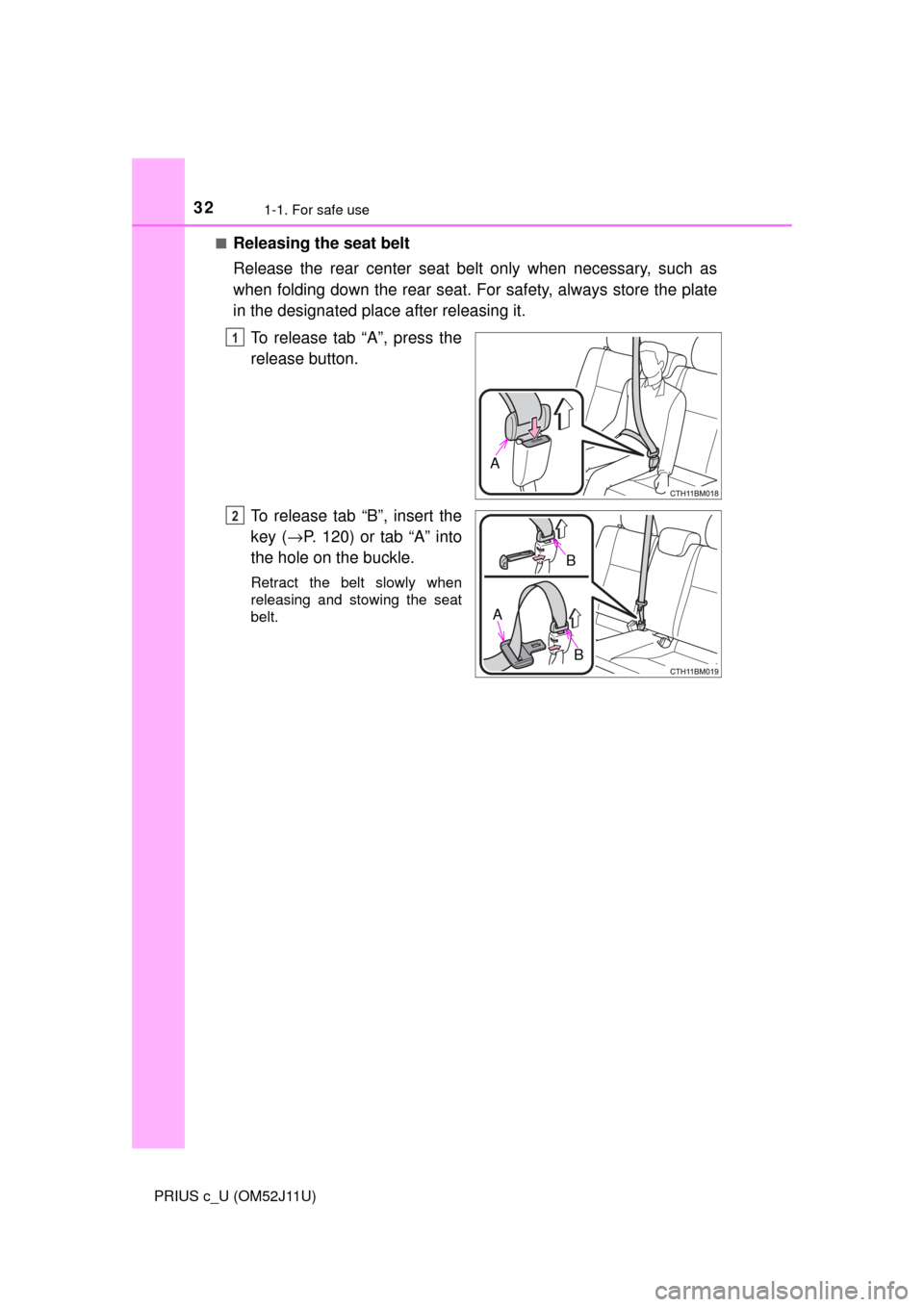
321-1. For safe use
PRIUS c_U (OM52J11U)■
Releasing the seat belt
Release the rear center seat
belt only when necessary, such as
when folding down the rear seat. For safety, always store the plate
in the designated place after releasing it.
To release tab “A”, press the
release button.
To release tab “B”, insert the
key ( →P. 120) or tab “A” into
the hole on the buckle.
Retract the belt slowly when
releasing and stowing the seat
belt.
A
1
A
B
B
2
Page 33 of 596
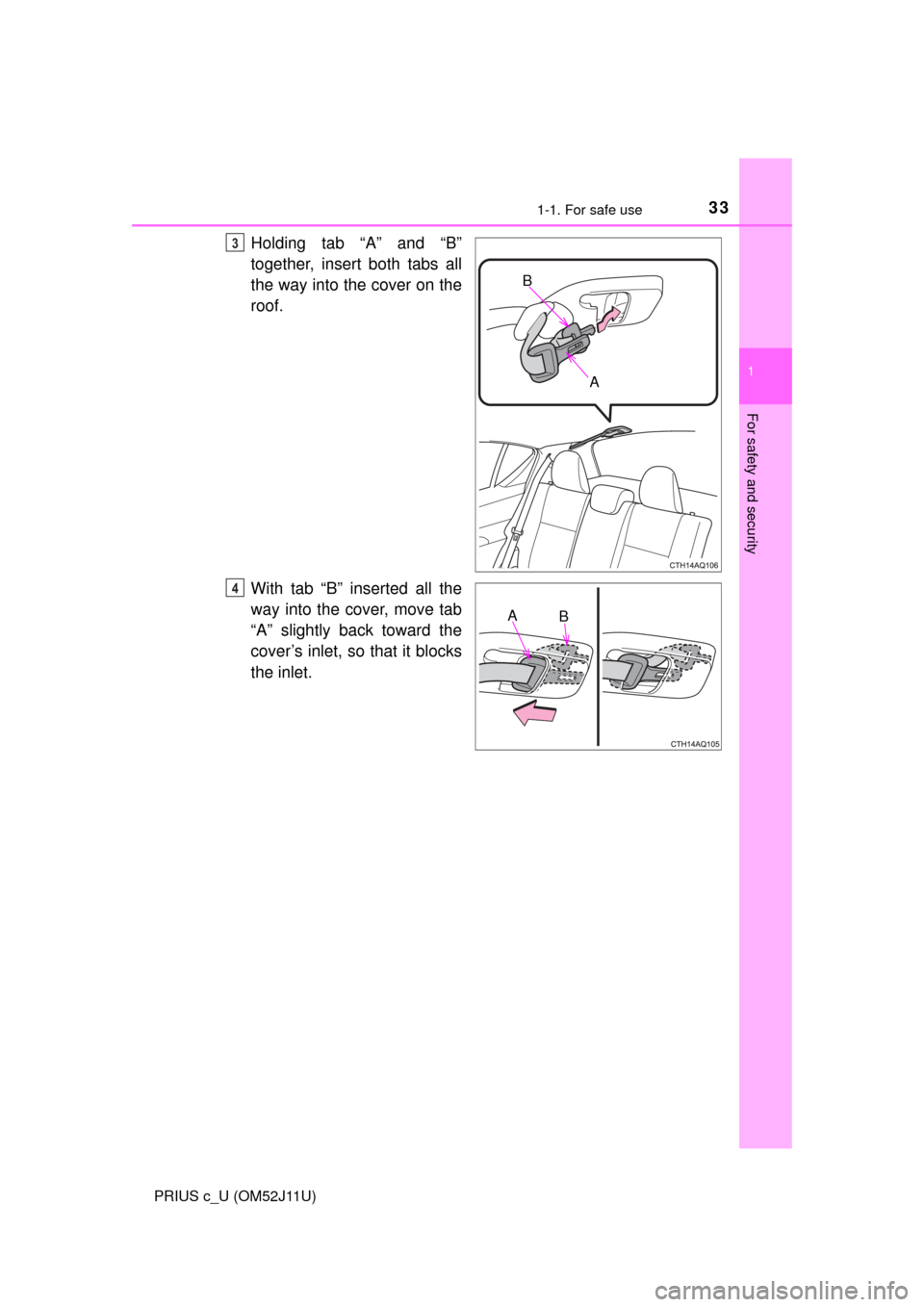
331-1. For safe use
1
For safety and security
PRIUS c_U (OM52J11U)
Holding tab “A” and “B”
together, insert both tabs all
the way into the cover on the
roof.
With tab “B” inserted all the
way into the cover, move tab
“A” slightly back toward the
cover’s inlet, so that it blocks
the inlet.
B
A
3
BA
4
Page 37 of 596
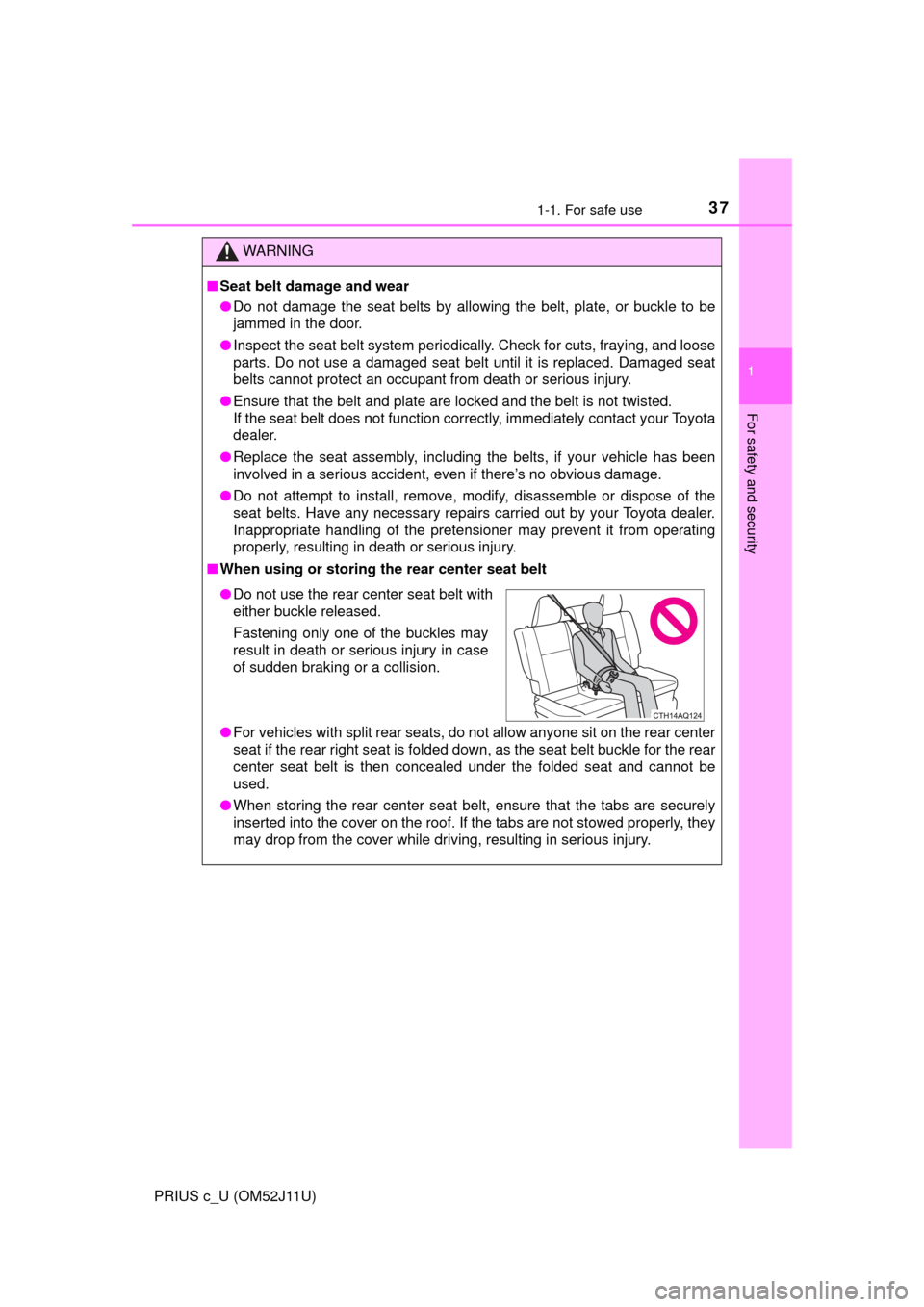
371-1. For safe use
1
For safety and security
PRIUS c_U (OM52J11U)
WARNING
■Seat belt damage and wear
● Do not damage the seat belts by allowing the belt, plate, or buckle to be
jammed in the door.
● Inspect the seat belt system periodically. Check for cuts, fraying, and loose
parts. Do not use a damaged seat belt until it is replaced. Damaged seat
belts cannot protect an occupant from death or serious injury.
● Ensure that the belt and plate are locked and the belt is not twisted.
If the seat belt does not function correctly, immediately contact your Toyota
dealer.
● Replace the seat assembly, including the belts, if your vehicle has been
involved in a serious accident, even if there’s no obvious damage.
● Do not attempt to install, remove, modify, disassemble or dispose of the
seat belts. Have any necessary repairs carried out by your Toyota dealer.
Inappropriate handling of the pretensioner may prevent it from operating
properly, resulting in death or serious injury.
■ When using or storing the rear center seat belt
● For vehicles with split rear seats, do not allow anyone sit on the rear center
seat if the rear right seat is folded down, as the seat belt buckle for the rear
center seat belt is then concealed under the folded seat and cannot be
used.
● When storing the rear center seat belt, ensure that the tabs are securely
inserted into the cover on the roof. If the tabs are not stowed properly, they
may drop from the cover while driving, resulting in serious injury.
●Do not use the rear center seat belt with
either buckle released.
Fastening only one of the buckles may
result in death or serious injury in case
of sudden braking or a collision.
Page 42 of 596

421-1. For safe use
PRIUS c_U (OM52J11U)
Your vehicle is equipped with ADVANCED AIRBAGS designed based
on the US motor vehicle safety standards (FMVSS208). The airbag
sensor assembly (ECU ) controls airbag deployment based on infor-
mation obtained from the sensors et c. shown in the system compo-
nents diagram above. This informat ion includes crash severity and
occupant information. As the airbags deploy, a chemical reaction in
the inflators quickly fills the airbag s with non-toxic gas to help restrain
the motion of the occupants.
WARNING
■ SRS airbag precautions
Observe the following precautions regarding the SRS airbags.
Failure to do so may cause death or serious injury.
● The driver and all passengers in the vehicle must wear their seat belts
properly.
The SRS airbags are supplemental devices to be used with the seat belts.
● The SRS driver airbag deploys with considerable force, and can cause
death or serious injury especially if the driver is very close to the airbag.
The National Highway Traffic Safety Administration (NHTSA) advises:
Since the risk zone for the driver’s airbag is the first 2 - 3 in. (50 - 75 mm)
of inflation, placing yourself 10 in. (250 mm) from your driver airbag pro-
vides you with a clear margin of safety. This distance is measured from
the center of the steering wheel to your breastbone. If you sit less than 10
in. (250 mm) away now, you can change your driving position in several
ways:
• Move your seat to the rear as far as you can while still reaching the ped- als comfortably.
• Slightly recline the back of the seat. Although vehicle designs vary,
many drivers can achieve the 10 in. (250 mm) distance, even with the
driver seat all the way forward, simply by reclining the back of the seat
somewhat. If reclining the back of your seat makes it hard to see the
road, raise yourself by using a firm, non-slippery cushion, or raise the
seat if your vehicle has that feature.
• If your steering wheel is adjustable, tilt it downward. This points the air-
bag toward your chest instead of your head and neck.
The seat should be adjusted as recommended by NHTSA above, while
still maintaining control of the foot pedals, steering wheel, and your v\
iew
of the instrument panel controls.
Page 44 of 596

441-1. For safe use
PRIUS c_U (OM52J11U)
WARNING
■SRS airbag precautions
● Do not allow a child to stand in front of
the SRS front passenger airbag unit or
sit on the knees of a front passenger.
● Do not allow the front seat occupants to
hold items on their knees.
● Do not lean against the door, the roof
side rail or the front, side and rear pil-
lars.
● Do not allow anyone to kneel on the
passenger seat toward the door or put
their head or hands outside the vehicle.
● Do not attach anything to or lean any-
thing against areas such as the dash-
board, steering wheel pad and lower
portion of the instrument panel.
These items can become projectiles
when the SRS driver, front passenger
and driver knee airbags deploy.
Page 82 of 596
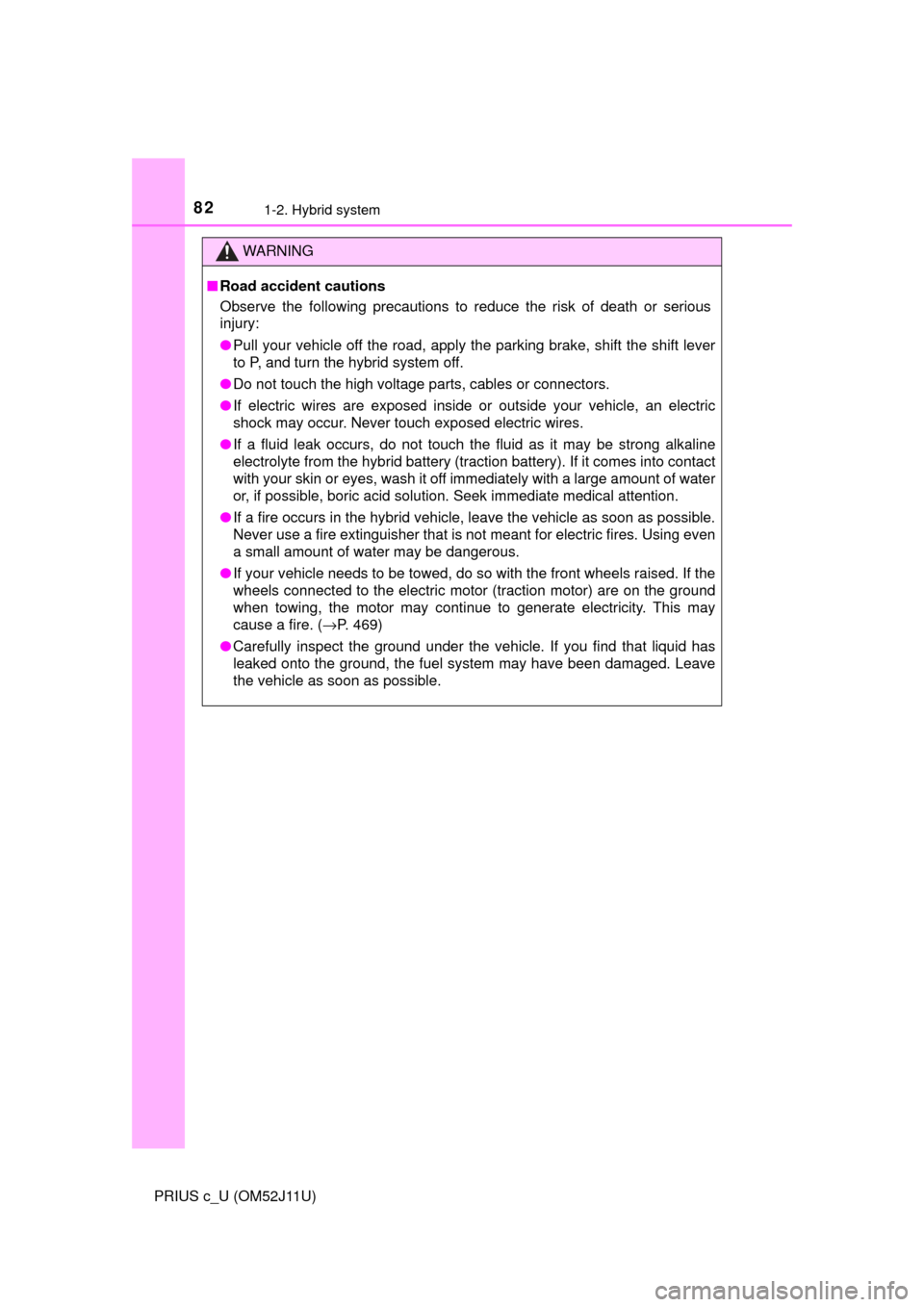
821-2. Hybrid system
PRIUS c_U (OM52J11U)
WARNING
■Road accident cautions
Observe the following precautions to reduce the risk of death or serious
injury:
● Pull your vehicle off the road, apply the parking brake, shift the shift lever
to P, and turn the hybrid system off.
● Do not touch the high voltage parts, cables or connectors.
● If electric wires are exposed inside or outside your vehicle, an electric
shock may occur. Never touch exposed electric wires.
● If a fluid leak occurs, do not touch the fluid as it may be strong alkaline
electrolyte from the hybrid battery (traction battery). If it comes into contact
with your skin or eyes, wash it off immediately with a large amount of water
or, if possible, boric acid solution. Seek immediate medical attention.
● If a fire occurs in the hybrid vehicle, leave the vehicle as soon as possible.
Never use a fire extinguisher that is not meant for electric fires. Using even
a small amount of water may be dangerous.
● If your vehicle needs to be towed, do so with the front wheels raised. If the
wheels connected to the electric motor (traction motor) are on the ground
when towing, the motor may continue to generate electricity. This may
cause a fire. ( →P. 469)
● Carefully inspect the ground under the vehicle. If you find that liquid has
leaked onto the ground, the fuel system may have been damaged. Leave
the vehicle as soon as possible.
Page 133 of 596
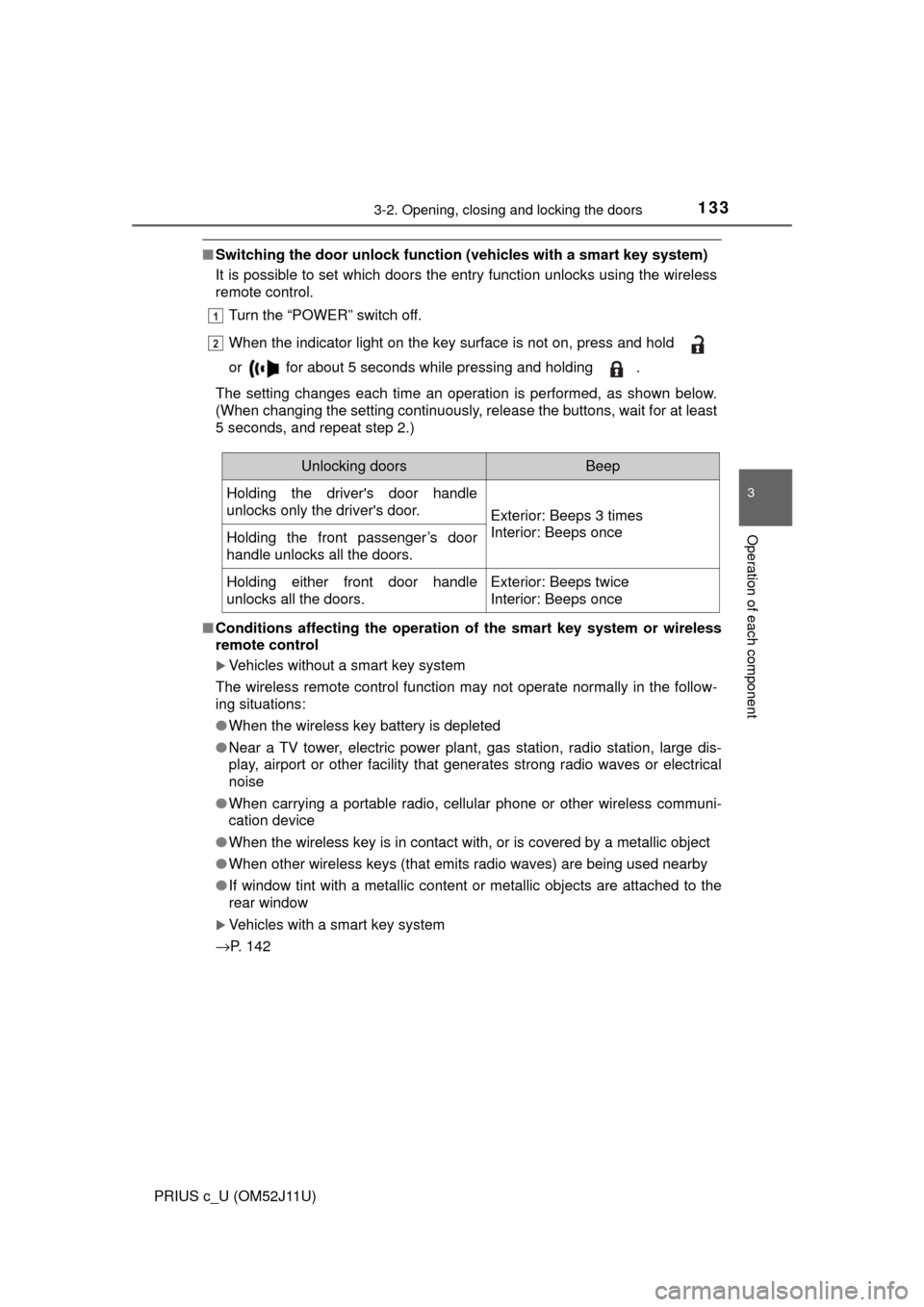
1333-2. Opening, closing and locking the doors
3
Operation of each component
PRIUS c_U (OM52J11U)
■Switching the door unlock functi on (vehicles with a smart key system)
It is possible to set which doors the entry function unlocks using the wireless
remote control.
Turn the “POWER” switch off.
When the indicator light on the key surface is not on, press and hold
or for about 5 seconds while pressing and holding .
The setting changes each time an operation is performed, as shown below.
(When changing the setting continuously, release the buttons, wait for at least
5 seconds, and repeat step 2.)
■ Conditions affecting the operation of the smart key system or wireless
remote control
Vehicles without a smart key system
The wireless remote control function may not operate normally in the follow-
ing situations:
● When the wireless key battery is depleted
● Near a TV tower, electric power plant, gas station, radio station, large dis-
play, airport or other facility that generates strong radio waves or electrical
noise
● When carrying a portable radio, cellul ar phone or other wireless communi-
cation device
● When the wireless key is in contact with, or is covered by a metallic object
● When other wireless keys (that emits radio waves) are being used nearby
● If window tint with a metallic content or metallic objects are attached to the
rear window
Vehicles with a smart key system
→P. 142
1
2
Unlocking doorsBeep
Holding the driver's door handle
unlocks only the driver's door.
Exterior: Beeps 3 times
Interior: Beeps once
Holding the front passenger’s door
handle unlocks all the doors.
Holding either front door handle
unlocks all the doors.Exterior: Beeps twice
Interior: Beeps once